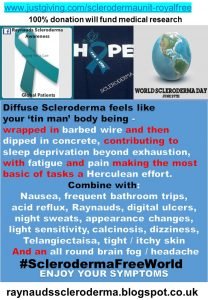Managing Symptoms: My Job Today is Simply to Get Better
Written by |

One of my biggest challenges of living with the chronic, incurable, and rare disease scleroderma and Raynaud’s, is that I am no longer physically able to maintain my professional career as a practicing barrister. The last time that I wore my court robes, wig and gown, was June 29, 2004 at Leicester Crown Court (England). This date, randomly some years later, was set as World Scleroderma Day.
I had started to decrease my daily dose of 2g mycophenolate that I had taken for the previous five years. At the start of March 2004, and by the end of June 2004, I was physically exhausted from pushing my body to perform a 60-hour week while taking such a high dose of immunosuppressants/chemotherapy.
If I was to have a remote chance of getting better, I had to accept that my body needed a rest, and a change in my lifestyle. I sold my house and relocated to my birth town of Southport, on the northwest coast of England. It was there that maintaining my symptoms to a manageable level became, and still remain, my full-time job.
 Sunday nights used to be my worst night in the abyss of accepting my “non-working” reality. That is quite ironic really, since when at work I would sometimes have the “Sunday night – pre-Monday blues.” Here I was, wishing for that to be my reality again, missing the “old me.” It never occurred to me that one day I would wake up and never get better.
Sunday nights used to be my worst night in the abyss of accepting my “non-working” reality. That is quite ironic really, since when at work I would sometimes have the “Sunday night – pre-Monday blues.” Here I was, wishing for that to be my reality again, missing the “old me.” It never occurred to me that one day I would wake up and never get better.
I would spend days, which turned into weeks, then months and years, in agony. I was barely able to do the simplest of tasks, while the pain of my entire body, and lack of sleep as a consequence, dictated what had become my reality. Upon my enforced career change to repairing my body, my full attention is dedicated to minimizing my symptoms to a more tolerable and manageable level. This is driven by the desire to get better.
Over the course of the past few years, my return-to-well-being routine has allowed me to “test” several adventures, to assess the level of the actual reality of my return to work.
In 2015, I was honoured to present ‘Systemic Sclerosis – a Patient’s Perspective’ at the annual British Society for Rheumatology (BSR) conference, which was held in Manchester that year. (To read a synopsis of the scleroderma sessions held at last year’s conference click here). Weeks of advance preparation were put into place, along with the three-hour routine required to allow me out of the front door. While sitting at Southport train station at 6.30 a.m., I thought to myself what a miracle it was that I was there! Sadly, the experience of the train journey confirmed why public transport is not an option for my tin-man body and Raynaud’s sensitivity. Accompanied by several sets of stairs, which are a no-go for me.
Although I very much enjoyed the day and its contents, the entire physical exertion forced me to return to my bed for the next 10 days. Unfortunately, the 10-day recovery period still remains a precedent following any big day out. I have to be super-organized with managing my time and, in particular, any meetings in London, via my roles with the EMA, or NHS England.
In 2015 I was honored to have been a member of the group to present at the European Parliament for World Scleroderma Day, in Brussels. However, the six-week bed rest needed following the physical exertion of this trip was a harsh reminder as to why I had not been abroad for more than a decade.
All in all, I have to remind myself that having a job role or status does not define who I am. I have shared more of my coping strategies in relation to this on my personal blog. And, for the days when my body is in protest for having pushed myself too much, forcing me back to my bed, I must remember that my job today is to simply get better.
Living the dream, scleroderma style.
#SclerodermaFreeWorld #RaynaudsFreeWorld
Please make a donation here to fund medical research at the scleroderma unit where 100% of your monies will be used for research purposes only. Thank you.
***
Note: Scleroderma News is strictly a news and information website about the disease. It does not provide medical advice, diagnosis, or treatment. This content is not intended to be a substitute for professional medical advice, diagnosis, or treatment. Always seek the advice of your physician or other qualified health provider with any questions you may have regarding a medical condition. Never disregard professional medical advice or delay in seeking it because of something you have read on this website. The opinions expressed in this column are not those of Scleroderma News, or its parent company, Bionews Services, and are intended to spark discussion about issues pertaining to scleroderma.







Leave a comment
Fill in the required fields to post. Your email address will not be published.